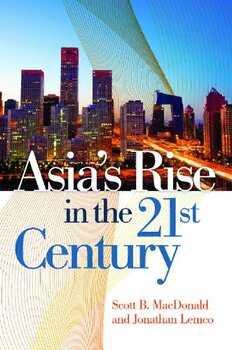
Asia's Rise in the 21st Century PDF
Preview Asia's Rise in the 21st Century
Asia’s Rise in the 21st Century ASIA’S RISE IN THE 21ST CENTURY Scott B. MacDonald and Jonathan Lemco Copyright2011byScottB.MacDonaldandJonathanLemco Allrightsreserved.Nopartofthispublicationmaybereproduced,storedinaretrieval system,ortransmitted,inanyformorbyanymeans,electronic,mechanical, photocopying,recording,orotherwise,exceptfortheinclusionofbriefquotationsina review,withoutpriorpermissioninwritingfromthepublisher. LibraryofCongressCataloging-in-PublicationData MacDonald,ScottB. Asia’sriseinthe21stcentury/ScottB.MacDonaldandJonathanLemco. p.cm. Includesbibliographicalreferencesandindex. ISBN978–0–313–39370–9(pbk.:alk.paper)—ISBN978–0–313–39371–6(ebook) 1.Economicdevelopment—China—21stcentury.2. Economicdevelopment—Asia— 21stcentury.3. China—Economicconditions—21stcentury.4. Asia—Economic conditions—21stcentury.5. Asia—Economicintegration—21stcentury. I.Lemco, Jonathan.II.Title. HC427.95.M337 2011 330.95—dc23 2011025912 ISBN:978–0–313–39370–9 EISBN:978–0–313–39371–6 15 14 13 12 11 1 2 3 4 5 ThisbookisalsoavailableontheWorldWideWebasaneBook. Visitwww.abc-clio.comfordetails. Praeger AnImprintofABC-CLIO,LLC ABC-CLIO,LLC 130CremonaDrive,P.O.Box1911 SantaBarbara,California93116-1911 Thisbookisprintedonacid-freepaper ManufacturedintheUnitedStatesofAmerica CONTENTS Preface vii 1. Introduction 1 2. The Great Divergence 14 3. The Rise of China 33 4. Constructing the New Asian Economy 55 5. The Supporting Cast: BRICs and Beyond 74 6. The Major Economic Challenges 94 7. Political Challenges in Asia 115 8. The West and the Rise of Asia 134 9. Conclusion 151 Notes 161 Bibliography 175 Index 189 PREFACE Several centuries ago, Asia was ahead of Europe in many areas. Around 1500 the two regions started to diverge, and Asia fell behind. The West (which came to include North America) went ahead—economically and militarily—and has long been the dominant force, pushed along by the globalizingtendenciesofIberian-,Dutch-,French-,British-,andcurrently U.S.-dominated international systems. That is changing, however, with the sustained resurgence of Asia’s economies since the second half of thetwentiethcentury.TheriseofChinaisaparticularcatalystinthispro- cess,adevelopmentthatiscomplementedbyadvancesinotheremerging Asian economies, in particular India, Korea, Singapore, Thailand, and Indonesia. In a very broad sense, Asia is closing in on the West in terms of economic and political power. With this highly significant develop- ment, it is critical to understand that the terms of the debate about global power and globalization are changing. Globalization, the process by which local markets and cultures are becoming more uniform and stand- ardized as to international norms and practices, is no longer a Western phenomenon. It is increasingly a compositewith growing Asian content. Thisisamajorchangefromthe1990sandearly2000swhenglobalization was synonymous with the United States. If nothing else, the global economiccrisisof2008–9underscoredthatfortheglobaleconomytostay afloat and move to a recovery mode, policies needed to be synchronized and that Asia,China in particular,had avery important roleto play. It is important for the rest of theworld to understand these trends and their implications. For the business community, be it finance, retail, or viii PREFACE manufacturing, the need to have a better comprehension of the changing Asianeconomyandtheregion’srisingpowerismoreimportantthanever. Ignoranceoftheoutsideworlddoesnotstandasanexcuseinaglobalized economy.AmericansshouldheedthewordsofSingapore’sformerambas- sadortotheUnitedNationsanddeanoftheLeeKuanYewSchoolofPub- lic Policyat the National University of Singapore: “No country did more than the United States to spark the rise of East Asia. But paradoxically, America is among the countries least prepared to handle the rise of East Asia.”1 Indeed, ignorance of the rest of the planet is an invitation for misunderstandings and the spread of xenophobia, isolationism, and protectionism, all detriments to the advances of the exchange of goods, services, andideas. This bookismeanttoinformandmakepeoplethink,eveniftheyhave profounddisagreementswithourviews.Alongtheselines,webelievethat thetwenty-firstcenturywillbedefinedbytheriseofAsia,theimpactofa China-dominated region, and the response of the West to these trends. CertainlypartoftheequationisthenatureoftheSino-Americanrelation- ship, but it is also defined by China’s interactions with Brazil, Russia, India, and China (the BRICs) and other emerging market countries, such asSouthAfrica,Turkey,Indonesia,andColombia.Consideringtheimpor- tance of emerging markets to global economic growth, the rise of Asia mustbe observed through its linkagesto non-Western countries. TheaudienceforthisbookincludespeopleconductingbusinessinAsia, businessstudentsthataresoontoenterthejobpool,andstudentsofAsian studies and international economics. Considering Asia’s already wide- ranging impact on the West, the trend appears to be accelerating in the 2010s, making the need to understand the region all the more important in terms of strategic planning, business development, and even personal lifestyles. If nothing else, Asia and the West remainvery closely linked, their economic strategies mutually reinforcing, with their objectives largely in the same zip code. Aworld of synchronized economic policies provides a far better business environment than aworld of out-of-control economic and political rivalries. And we have observed that shift before in the early twentieth century when the rise of Germany helped end a globalizingeconomicorder. Although manyhands helped stir the creativepot, the authors take full responsibility for their work. Theviews expressed here are our own and do not in any fashion represent those of Aladdin Capital Management, LLC,orVanguard,thoughthesupportoftheseinstitutionsisappreciated. WewouldliketothankAndyMurkerjeeofBloomberg(Singapore);Leslie Norton of Barron’s Professor Emeritus Richard L. Sims of the School of PREFACE ix Oriental and African Studies (London); Professor William W. Grimes of the Department of International Relations, Boston University; Ricardo Hernandez of National Bank Financial; Dr. Dale Smith; Takahiro Onishi of Mitsubishi UFJ Securities International; Anusha Shrivastova (PhD) of Dow Jones; Li Zhu (PhD); and Steve Xia (PhD) of Vanguard’s Risk Management and Strategic Analysis group for their comments and time. Professor Elizabeth Hansen of the Department of Political Science, Universityof Connecticut was also a useful sourcewith whom to discuss ideas, especially onglobalization and India. Thanksare equallyextended to Professor Yu Zheng, Department of Political Science, University of Connecticut. We also benefited from discussions on globalization and Japan with Kenji Kobiyashi of Mitsubishi Corporation. David Levey, formerly of Moody’s, was most helpful in supplying a number of thought-provokingarticles. Last, but hardly least, the authors, Scott B. MacDonald in particular, would like to acknowledge their gratitude through theyears to Professor Albert L. Gastmann, Department of Political Science, Trinity College, who passed away in 2007. Hewas always ready for rigorous intellectual debate,entertainingtales,goodfood,andfinewine.Hispresenceasfriend and mentor is sorely missed, especially his ability to point out important nuances as he did in the early stages of this book. Gratitude is also extended by MacDonald to another Professor of Political Science at TrinityCollege,RanbirVohra,whowasasignificantinfluenceinhislook- ing East—allof thoseseminars onChinese politicsdid payoff. Theauthorswouldalsoliketothanktheirfamiliesfortheirsupportand indulgence.Without them,none of thiswork wouldbeworthit.
